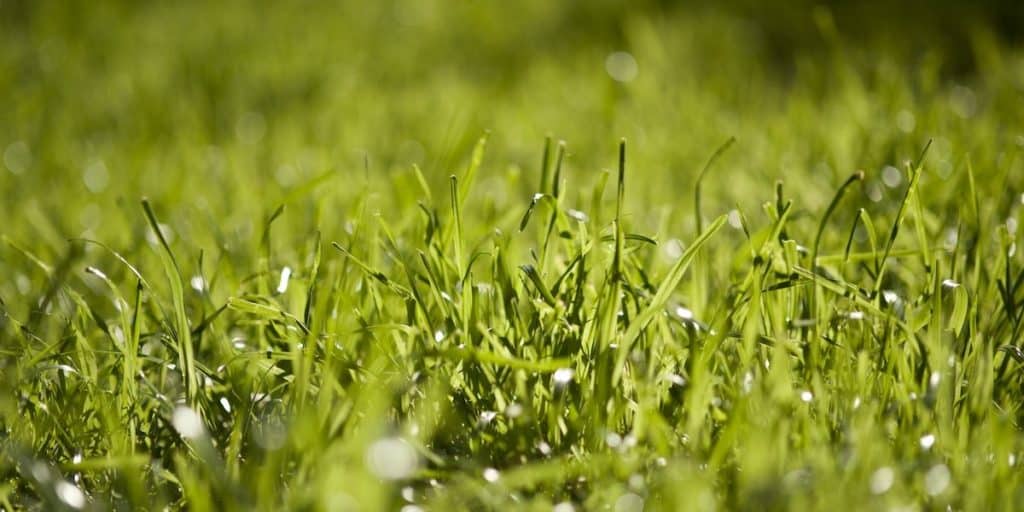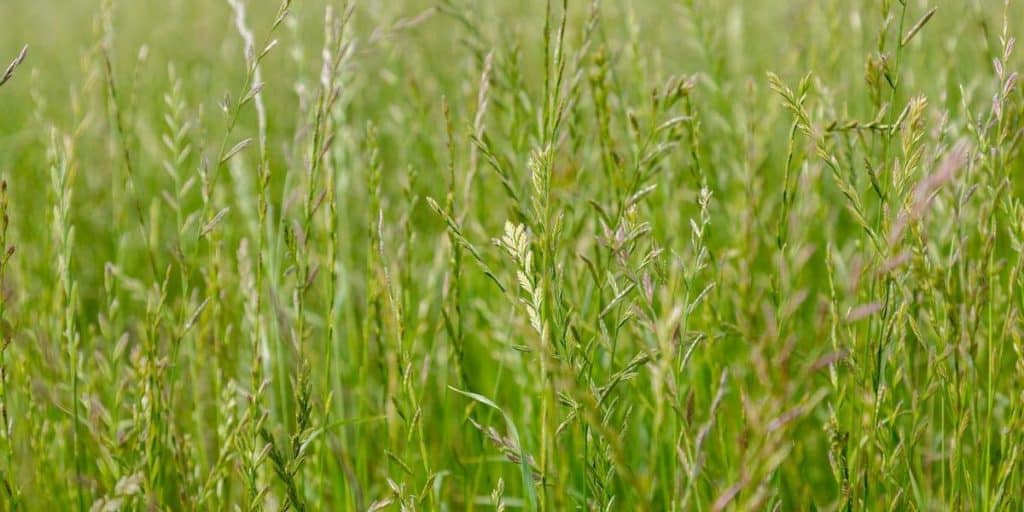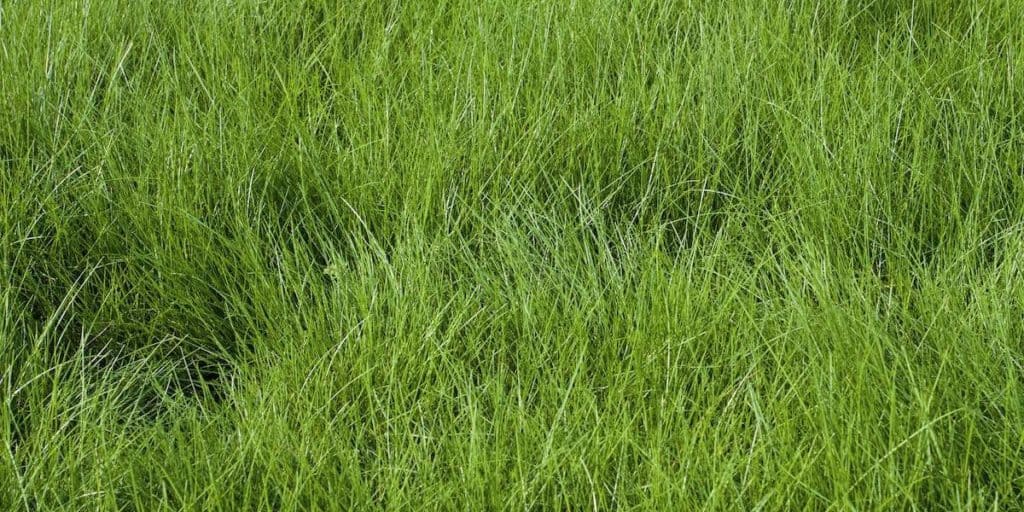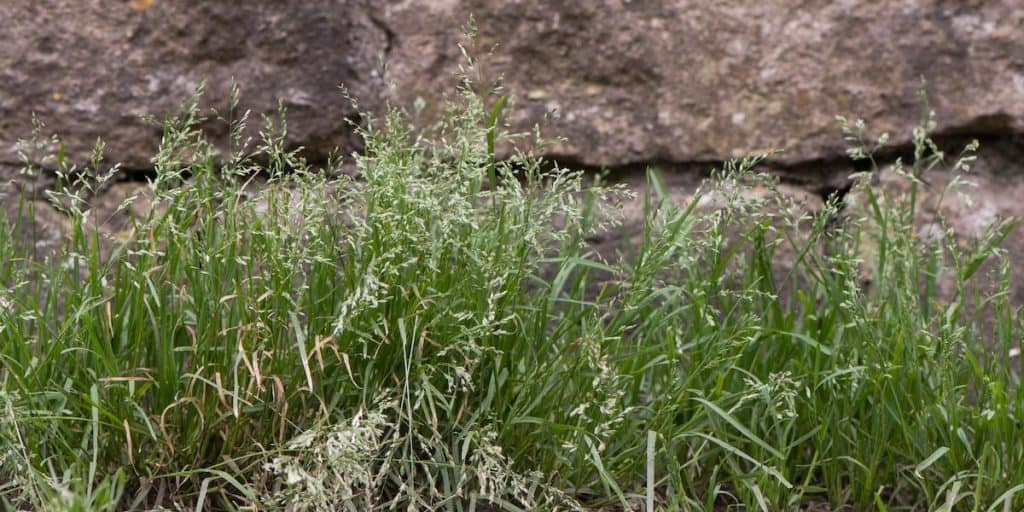The planting season has already passed, and you forgot to plant your grass. With winter quickly approaching, you’re left wondering what kind of grass seeds you can plant that will grow through the harsh, cold weather conditions of the upcoming season.
Some grass seed varieties that will grow in winter include Kentucky Bluegrass, Tall Fescue, Ryegrass, Velvet Bentgrass, Colonial Bentgrass, Fine Fescue, Meadow Grass, Creeping Bentgrass, and Red Fescue.
Today I’ll discuss the best grass varieties to plant in winter and what you can do to help them develop to their full potential. Keep in mind as we jump into this that not all winter grasses are built for harsher winters, but most of the ones discussed below fare well even in harsher conditions.
1. Kentucky Bluegrass

Kentucky Bluegrass is by far the best-known cold season variety. This grass has been around since colonial times and is a favorite among gardeners everywhere.
With its thick, broad leaves, this grass leaves you the impression that the lawn it’s a part of is high quality. The texture of this grass is also one of the things that makes it a great winter grass. The thick leaves hold up well under the weight of the ice that often settles on them during the winter months.
Kentucky Bluegrass has a relatively shallow root system, typically not tolerant in drought. This is another reason why this is such good winter grass. Winter is full of precipitation in most places, ensuring this grass gets plenty of extra water.
Nowadays, Kentucky Bluegrass is mixed with various other types of grass in seed blends. Usually, it’s mixed with Perennial Ryegrass, which we will discuss in a little more depth in a moment. It may also be mixed with Creeping Red Fescue, another winter-tolerant grass.
If left uncut, Kentucky Bluegrass will grow between 18 and 24 inches (45.72 and 60.96 cm) tall. However, you usually will want to keep it no taller than 2.5 inches (6.35 cm) for lawn usage.
This variety grows best on longer days due to the amount of light in the day. On shorter days, the grass often becomes decumbent. However, more shoots are produced on shorter days in late winter and early spring.
2. Improved Tall Fescue

Fescue grasses are another great winter option. Tall Fescue has thin, delicate leaves, unlike its broad-leaf counterparts. It often ends up being the perfect grass for long walks and children’s playgrounds.
Improved Tall Fescue is built for winter. This grass was originally not heat tolerant at all, but over time it was improved to withstand some of the summer heat. Its natural gravitation towards colder weather is what makes this grass such an excellent option for planting in the winter.
One of the best qualities of Improved Tall Fescue is its high tolerance. This grass is tolerant of heat, drought, and shade. It is also enormously tolerant of both colder and milder winters, depending on what geographical climate you’re planting in.
This grass is also highly resistant to disease. Many types of grass, even winter grasses, weaken in the cold weather. Improved Tall Fescue, despite its delicate leaves, is enormously strong. It maintains its health even in more challenging climates.
Improved Tall Fescue originated in Europe and was introduced to the United States sometime in the early 1800s. It came at the perfect time for lawns to become fashionable. It was first discovered as a winter-loving grass during this time when colonial peoples began planting it in their lawns during the cold winter months.
This grass grows best when planted at the beginning of winter, unlike many other kinds of grass that do better near the end of winter. It will flourish during the coldest months of the year, growing in bunches to maintain warmth.
This type of grass is sometimes grown on its own, but more often, it’s mixed in seed blends. This is because it tends to grow in bunches. Often, coverage is limited with Improved Tall Fescue alone. However, if enough is planted, it grows wonderfully.
3. Perennial Ryegrass

Perennial Ryegrass, and all Ryegrass varieties, are one of the most popular options for winter grasses. It’s not the top option for winter grasses because it doesn’t always do well surviving through the entirety of winter. Instead, this grass flourishes when planted at the end of winter.
Perennial Ryegrass has become a winter grass over time through various gene mutations. However, it took time to adapt to the colder weather fully.
This grass flourishes in climates that maintain a more mild winter. For example, the grass flourishes in Alabama, Georgia, and Florida. In Northern climates, it’s hit or miss. Often when it’s intermixed with other grass varieties, such as Kentucky Bluegrass, it’s sufficiently more hardy through the winter months.
Perennial Ryegrass works well for grazing because of the seeds that cluster on the top of the grass stalks. Many farmers plant it in late fall for their herds to graze on throughout the few early months of winter.
It will begin to die off after the first frost, but you’ll hardly notice if it’s intermixed with other seeds. You can expect it to make a big comeback shortly after the harshest winter months have passed – usually around late February or early March.
4. Velvet Bentgrass

Like many other hardy winter varieties, Velvet Bentgrass began in Europe. It is assumed that so many winter grasses came from Europe because colonial peoples brought them over during the 1800s.
Velvet Bentgrass is just one species of Bentgrass. It’s most commonly grown with other grasses on golf courses. This is primarily because of its prostrate growth patterns.
This grass is enormously dense and an excellent option for covering large areas. It’s also one of the few species of winter grass known to have high-stress endurance, even amid heavy frost and snow.
This grass is best suited to areas farther North and has limited options for winter grasses. It’s fantastic at retaining color, primarily due to the deep root system of the grass.
Interestingly, Velvet Bentgrass isn’t used as commonly as some others for winter planting. Perhaps because it is less discussed. In addition, it isn’t usually part of a mix of seeds, unlike some of the other varieties we’ve discussed today.
5. Colonial Bentgrass
Another variety of Bentgrass, Colonial Bentgrass, is known for its straight and smooth texture. Like its Velvet Bentgrass counterpart, it is often used for golf courses due to its matting growth patterns.
One of the best things about this grass is that it is incredibly tolerant of being cut to various heights. This means that in the winter months, you can allow it to grow taller to help provide warmth to surrounding root systems. Conversely, you can cut it significantly shorter in the summer, so those same root systems get extra water.
Often, Colonial Bentgrass is mixed in with other seeds to help contribute density to other grass varieties that grow more sparsely or in bunches.
Like Velvet Bentgrass, this variety does well maintaining its color throughout the harsh winter months. However, it isn’t quite as hardy as the Velvet variety. Colonial Bentgrass does better when planted in environments with more mild winters.
Plant this grass during late fall or winter, but avoid planting in the middle of the cold season. When it’s too cold, it typically won’t take root.
6. Fine Fescue
Another type of Fescues, known as Fine Fescues, is a great winter option. Like their Improved Tall Fescue counterparts, Fine Fescues are known for their delicate thin leaves. Surprisingly enough, the delicacy doesn’t prevent them from flourishing in the winter months.
This type of grass maintains a grayish-to-green coloration through the colder months and is usually found in a seed mix rather than on its own.
It is one of the most tolerant types of grasses, surviving well in drought and shade. However, it will still flourish even if exposed to multiple types of precipitation. As previously discussed, this type of grass also has an enormously high tolerance for cold weather.
The downside to this grass is the heat tolerance is fairly low. This may not be the best grass to plant if you live in a climate that alternates between hot summers and cold winters. The exception would be if you’re planting biannually and have other grass seeds set aside for the summer months.
If, however, you live in a climate with cooler summers, Fine Fescues can be a great asset to your lawn.
7. Annual Meadow Grass

Annual Meadow grass is known for its high tolerance to both cold and trampling levels. This grass is built for environments that don’t need to be kept pristine.
This grass grows well over large areas for maximum coverage. New sprouts typically start small and folded. As time progresses, the leaves spread out to take up a significant amount of space.
One thing that should be noted is that Annual Meadow grass is considered an invasive grass species. While it does hold up quite well in winter, it also flourishes in the spring and summer. Without too much effort, the species can completely invade an entire yard.
While this grass is suitable for large areas, it does tend to cluster. This is a quality that makes the species more sustainable for winter growth. However, it doesn’t always lead to the most beautiful aesthetics.
8. Creeping Bentgrass
It seems that all forms of Bentgrass are excellent for winter growth. However, the Creeping Bentgrass is one of the absolute best kinds.
This grass is most well known for its ability to continue growing throughout the winter months at almost the same rate as it does throughout the warmer months. The downside to this grass is that it doesn’t always do well in snow.
Creeping Bentgrass is pretty prone to snow molds, unlike other winter grasses. If you live in an area where this is common, it would be best to avoid this grass.
However, if you’re planting an area that gets cold without the excess snow, Creeping Bentgrass may be just what you’re looking for.
9. Chewings Red Fescue
Another Fescue variety, Chewings Red Fescue, is well known for being extremely winter hardy. Even better than Creeping Bentgrass, this fine-leafed tufted grass excels in growth during the winter months.
One significant advantage of this variety is its high tolerance to snow molds. This means that even if you live where mold is expected in winter, you probably won’t have too much of an issue.
Similar to other Fescue varieties, Chewings Red Fescue is fantastic for covering large areas of the ground. Additionally, it makes for a great lawn to lie down in or walk through barefoot.
You can expect this grass species to continue to grow in winter, spring, summer, and fall. It almost always grows well. However, you may notice difficulty if you place it in extreme heat.
Tips for Planting Winter Grasses
Now that we’ve discussed the many varieties of winter grasses, it’s essential to know the best way to grow them. Planting in the winter is a delicate process at times, after all, there’s a wider array of factors to consider.
Check out the tips below to help your winter seeds flourish.
Make Sure Your Seeds Come in Direct Contact With the Bare Soil
This is an essential part of planting during winter. If the seeds aren’t able to burrow into the soil, they’ll die off before they can sprout.
Planting your seeds in bare soil gives them the best chance of survival. It’s better if the soil has been freshly tilled, which we’ll discuss in a moment.
Plant the Seeds in Loose Soil
Loose soil allows the seeds to sink deeper into the earth. During winter, the ground is significantly harder than it is during the summer. This is due to a mix of less water in the ground in the winter and the cold temperatures freezing the earth.
You can make loose soil by tilling the ground with a tiller or by hand. You can also plant in garden soil that’s been laid over the ground. However, you risk the seeds not taking root in the regular ground if you choose garden soil.
Rake the Area Before Planting
Raking pulls all the debris out of the soil before planting. This will help rid the soil of debris and the root systems of other plants that have already taken root in the ground.
Weeds are notorious for continuing to grow no matter how much you’ve pulled at them and chopped at the root system. However, the more that you can get out initially with the raking, the less likely that they’ll end up taking over your newly planted lawn.
Follow All Seed Provider Guidelines
Different grasses need to spread in different ways; otherwise, they won’t grow well. This is even more the case in winter since the seeds are often more delicate than they would be in the spring.
It’s essential to follow all seed provider guidelines when spreading the seeds, covering them, and so on. For example, if the seed provider specifies that you should spread out the seeds thoroughly, and instead, you clump them together here and there, you’ll end up with only a small amount of coverage.
The seeds may also need to be planted away from certain other plants. Not all plants grow well together. Sometimes they nourish each other, but sometimes it’s the opposite. If you want your grass to grow well, you’ll want to keep the grass seed from the plants that pull nutrients away from your grass.
Rake the Surface After Seeding
Raking the surface after seeding your grass will help distribute the seeds evenly and improve coverage. It also encourages them to burrow a bit deeper into the loose soil.
I want to clarify that this is a light raking. The first raking you did to remove debris should be significantly heavier than the one to distribute the seeds. Too much pressure, and you’ll ruin many of the seeds. In addition, you can spread them away from the loose soil where you want them to grow.
Stay off Your Lawn
This is a really important part of winter planting for several reasons.
The main one is that the seeds take a little bit longer to actually implant in the ground during the winter. Even though you’re tilling the soil ahead of time, the root systems often need to burrow down into harder earth past the point of the tilling.
If you’re actively walking on your lawn during this time, it can push the seeds down too far before the root systems are ready to burrow into the harder earth.
Another reason is that walking on the freshly seeded lawn compacts the soil. You want the soil to remain loose so that the seeds can take root easily. Too much walking will make the ground just as hard as it was prior to tilling.
Instead, you should simply allow the weather to do its work – letting the snowfall compact the dirt at the right time.

